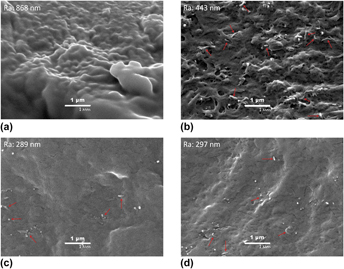Crossref Citations
This article has been cited by the following publications. This list is generated based on data provided by
Crossref.
Narayanamoorthy, B.
Panneerselvam, N.
Sita, C.
Pasupathi, S.
Balaji, S.
and
Moon, I. S.
2016.
Enhanced Stabilities of Ag Electrocatalyst as Self-Standing and Multiwalled Carbon Nanotube Supported Nanostructures for Oxygen Reduction in Alkaline Medium.
Journal of The Electrochemical Society,
Vol. 163,
Issue. 5,
p.
H313.
Stieven Montagna, Larissa
Amaral Montanheiro, Thaís Larissa do
Chiodi Borges, Aline
Yumi Koga‐Ito, Cristiane
Paula Lemes, Ana
and
Cerqueira Rezende, Mirabel
2017.
Biodegradation of PHBV/GNS nanocomposites by Penicillium funiculosum.
Journal of Applied Polymer Science,
Vol. 134,
Issue. 4,
Montagna, Larissa Stieven
Montanheiro, Thaís Larissa do Amaral
Machado, João Paulo Barros
Passador, Fábio Roberto
Lemes, Ana Paula
and
Rezende, Mirabel Cerqueira
2017.
Effect of Graphite Nanosheets on Properties of Poly(3-hydroxybutyrate-co-3-hydroxyvalerate).
International Journal of Polymer Science,
Vol. 2017,
Issue. ,
p.
1.
Tam, Nguyen Trong
Van Trinh, Pham
Anh, Nguyen Ngoc
Hong, Nguyen Tuan
Hong, Phan Ngoc
Minh, Phan Ngoc
and
Thang, Bui Hung
2018.
Thermal Conductivity and Photothermal Conversion Performance of Ethylene Glycol-Based Nanofluids Containing Multiwalled Carbon Nanotubes.
Journal of Nanomaterials,
Vol. 2018,
Issue. ,
p.
1.
Rivera-Briso, Ariagna L.
and
Serrano-Aroca, Ángel
2018.
Poly(3-Hydroxybutyrate-co-3-Hydroxyvalerate): Enhancement Strategies for Advanced Applications.
Polymers,
Vol. 10,
Issue. 7,
p.
732.
Montagna, Larissa Stieven
do Amaral Montanheiro, Thaís Larissa
Passador, Fábio Roberto
Lemes, Ana Paula
and
Rezende, Mirabel Cerqueira
2018.
The Influence of Artificial Photodegradation on Properties of Poly(3-hydroxybutyrate-co-3-hydroxyvalerate)(PHBV)/Graphite Nanosheets (GNS) Nanocomposites.
Journal of Polymers and the Environment,
Vol. 26,
Issue. 4,
p.
1511.
Lemes, Ana Paula
Montanheiro, Thaís Larissa do Amaral
da Silva, Ana Paula
and
Durán, Nelson
2019.
PHBV/MWCNT Films: Hydrophobicity, Thermal and Mechanical Properties as a Function of MWCNT Concentration.
Journal of Composites Science,
Vol. 3,
Issue. 1,
p.
12.
Nikbakht, Mohammad
Karbasi, Saeed
Rezayat, Seyed Mahdi
Tavakol, Shima
and
Sharifi, Esmaeel
2019.
Evaluation of the effects of hyaluronic acid on poly (3-hydroxybutyrate)/chitosan/carbon nanotubes electrospun scaffold: structure and mechanical properties.
Polymer-Plastics Technology and Materials,
Vol. 58,
Issue. 18,
p.
2031.
Braga, Natália F.
Zaggo, Henrique M.
Montanheiro, Thaís L. A.
and
Passador, Fabio R.
2019.
Preparation of Maleic Anhydride Grafted Poly(trimethylene terephthalate) (PTT-g-MA) by Reactive Extrusion Processing.
Journal of Manufacturing and Materials Processing,
Vol. 3,
Issue. 2,
p.
37.
Shah, Ankur Harish
Bhusari, Shardul
Djordjevic, Ivan
and
Steele, Terry W.J.
2019.
Twin screw extrusion of conductive citrate-based biomaterials.
European Polymer Journal,
Vol. 110,
Issue. ,
p.
176.
Montanheiro, Thaís Larissa do Amaral
Montagna, Larissa Stieven
Patrulea, Viorica
Jordan, Olivier
Borchard, Gerrit
Ribas, Renata Guimarães
Campos, Tiago Moreira Bastos
Thim, Gilmar Patrocínio
and
Lemes, Ana Paula
2019.
Enhanced water uptake of PHBV scaffolds with functionalized cellulose nanocrystals.
Polymer Testing,
Vol. 79,
Issue. ,
p.
106079.
Montanheiro, T L A
Campos, Tiago M B
Montagna, L S
da Silva, A P
Ribas, R G
de Menezes, Beatriz R C
Passador, F R
and
Thim, G P
2019.
Influence of CNT pre-dispersion into PHBV/CNT nanocomposites and evaluation of morphological, mechanical and crystallographic features.
Materials Research Express,
Vol. 6,
Issue. 10,
p.
105375.
Braga, Natália F.
LaChance, Anna Marie
Liu, Bin
Sun, Luyi
and
Passador, Fabio R.
2019.
Influence of compatibilizer and carbon nanotubes on mechanical, electrical, and barrier properties of PTT/ABS blends.
Advanced Industrial and Engineering Polymer Research,
Vol. 2,
Issue. 3,
p.
121.
Guerrero, L. Andrés
Fernández, Lenys
González, Gema
Montero-Jiménez, Marjorie
Uribe, Rafael
Díaz Barrios, Antonio
and
Espinoza-Montero, Patricio J.
2019.
Peroxide Electrochemical Sensor and Biosensor Based on Nanocomposite of TiO2 Nanoparticle/Multi-Walled Carbon Nanotube Modified Glassy Carbon Electrode.
Nanomaterials,
Vol. 10,
Issue. 1,
p.
64.
Amaral Montanheiro, Thaís L.
Montagna, Larissa Stieven
Machado, João Paulo Barros
and
Lemes, Ana Paula
2019.
Covalent functionalization of MWCNT with PHBV chains: Evaluation of the functionalization and production of nanocomposites.
Polymer Composites,
Vol. 40,
Issue. 1,
p.
288.
Montanheiro, Thaís Larissa do Amaral
de Menezes, Beatriz Rossi Canuto
Ribas, Renata Guimarães
Montagna, Larissa Stieven
Campos, Tiago Moreira Bastos
Schatkoski, Vanessa Modelski
Righetti, Victor Augusto Nieto
Passador, Fabio Roberto
and
Thim, Gilmar Patrocínio
2019.
Covalently γ-aminobutyric acid-functionalized carbon nanotubes: improved compatibility with PHBV matrix.
SN Applied Sciences,
Vol. 1,
Issue. 10,
Al-Husseini, Afnan H.
Saleh, Wasan R.
and
Al-Sammarraie, Abdulkareem M.A.
2019.
A Specific NH<sub>3</sub> Gas Sensor of a Thick MWCNTs-OH Network for Detection at Room Temperature.
Journal of Nano Research,
Vol. 56,
Issue. ,
p.
98.
da Silva, Ana Paula
do Amaral Montanheiro, Thaís Larissa
Stieven Montagna, Larissa
Andrade, Patrícia Fernanda
Durán, Nelson
and
Lemes, Ana Paula
2019.
Effect of carbon nanotubes on the biodegradability of poly(3‐hydroxybutyrate‐co‐3‐hydroxyvalerate) nanocomposites.
Journal of Applied Polymer Science,
Vol. 136,
Issue. 40,
Zomorodbakhsh, Shahab
Abbasian, Yasamin
Naghinejad, Maryam
and
Sheikhpour, Mojgan
2020.
<p>The Effects Study of Isoniazid Conjugated Multi-Wall Carbon Nanotubes Nanofluid on <em>Mycobacterium tuberculosis</em></p>.
International Journal of Nanomedicine,
Vol. Volume 15,
Issue. ,
p.
5901.
Joghataeian, Mohammadreza
Bahari, Ali
Qavami, Azra
and
Raeisi, Mohammad Javad
2020.
An antibacterial study of a new magnetic carbon nanotube/core-shell nanohybrids.
Journal of Environmental Chemical Engineering,
Vol. 8,
Issue. 5,
p.
104150.
